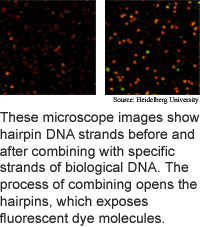
Glow shows individual DNA
Researchers from the University of Heidelberg in Germany and Florida State University have made a type of artificial DNA of that glows when it combines with a specific sequence of natural DNA.
In principle, the method could be used to develop DNA chips that directly sense individual DNA molecules, according to the researchers.
DNA is made from four types of bases -- adenine, cytosine, guanine, and thymine -- connected to a sugar-phosphate backbone. Double-stranded DNA forms when complementary bases in the two rows match and connect. A single strand of DNA can form a hairpin shape when matching segments along a single strand of DNA connect.
The researchers' used DNA strand that contains a fluorescent dye. It loses its glow when the molecule folds into a hairpin shape to bring the dye into contact with guanosine. When the DNA combines with another strand, for example, from a bacteria, the hairpin opens and exposes the fluorescent dye.
The researchers are working to develop DNA chips that can quickly detect small amounts of antibiotic-resistant bacteria. The method could also be used to detect other organisms as well.
The researchers are working on improving the detector's sensitivity.
The DNA sensor could be used in practical applications in two
to five years, according to the researchers. The work appeared in the
July 9, 2003 issue of Nano Letters.
Radio tags give guidance
Laser made from single atom
Web searches tap databases
Heated plastic holds proteins
News briefs:
Reflective dust IDs substances
Rapid process shapes aluminum
3D display goes deeper
Artificial DNA stacks metal atoms
Teamed lasers make smaller spots
Glow shows individual DNA

Research Watch blog
View from the High Ground Q&A
How It Works
RSS Feeds:
News
Ad links:
Buy an ad link
Ad links: Clear History
Buy an ad link
|
TRN
Newswire and Headline Feeds for Web sites
|
© Copyright Technology Research News, LLC 2000-2010. All rights reserved.